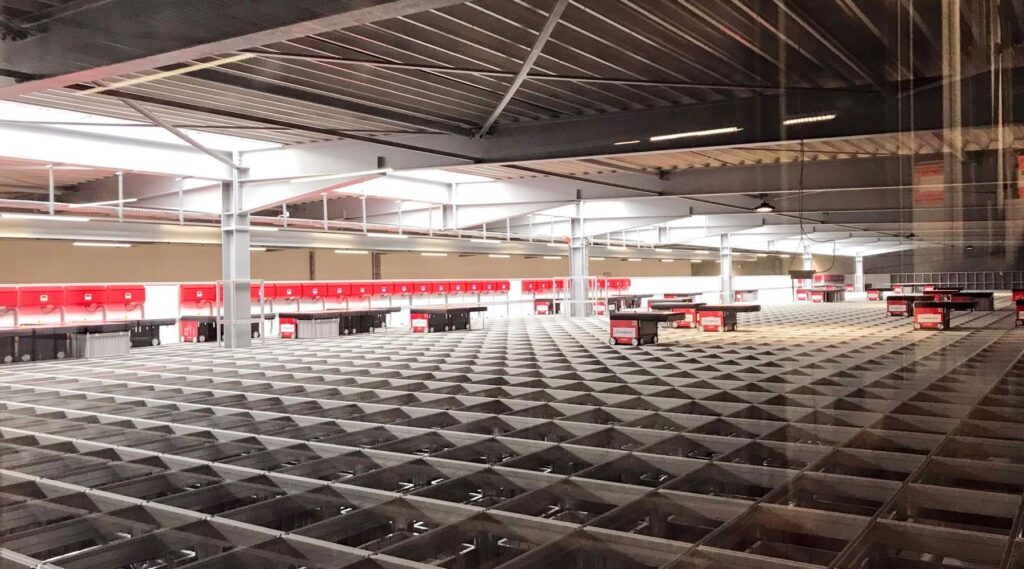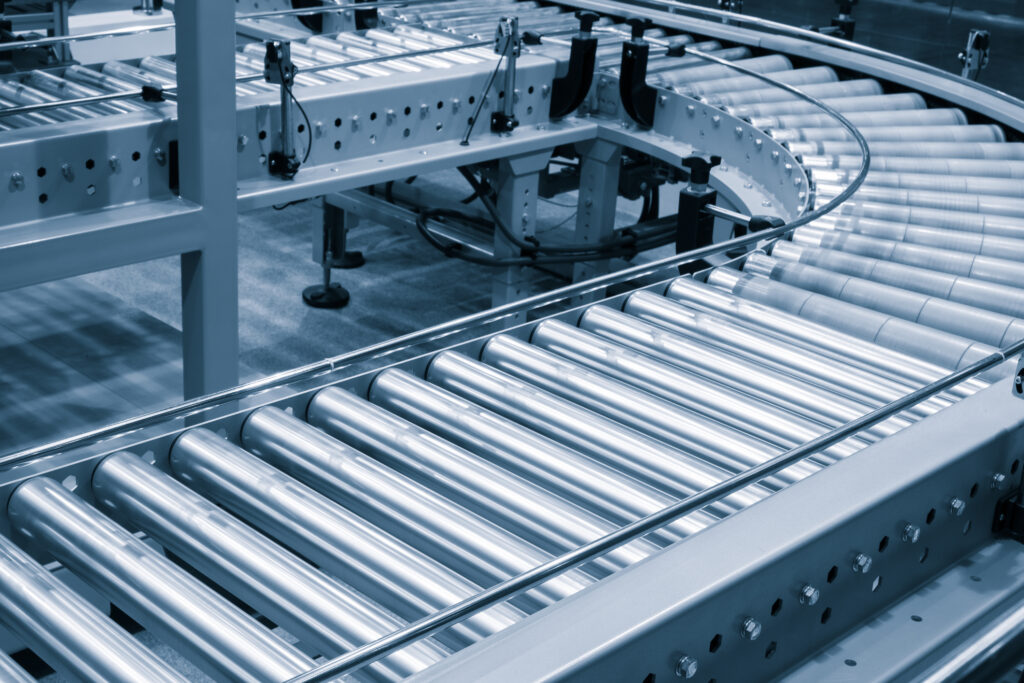In an era defined by technological innovation, the concept of Warehouse Automation has emerged as a transformative force in the realm of materials handling. In this blog we will delve into the various aspects of warehouse automation- what it is, its evolution, key components, and the pivotal role it plays in shaping the contemporary distribution landscape.
Defining Warehouse Automation
Warehouse Automation is a comprehensive approach to revolutionizing the traditional methods of handling and managing goods within a distribution center. It involves the strategic integration of advanced technologies, mechanical systems, and software solutions to automate various aspects of warehouse operations. The primary objective is to enhance efficiency, accuracy, and overall productivity throughout the supply chain.
This transformative process encompasses a spectrum of technologies such as Automated Storage and Retrieval Systems (ASRS), robotics, autonomous vehicles, conveyor systems, and sophisticated Warehouse Management Systems (WMS). These technologies work in harmony to optimize tasks like inventory management, order fulfillment, picking and packing, and transportation within the warehouse.
Warehouse Automation not only replaces manual labor in repetitive and time-consuming tasks but also leverages data analytics and real-time monitoring to make informed decisions. This results in improved operational speed, reduced errors, better space utilization, and ultimately, substantial cost savings. As industries evolve and consumer expectations rise, the adoption of Warehouse Automation becomes increasingly crucial for businesses striving to stay competitive, agile, and responsive in the dynamic landscape of modern materials handling.
The History of Warehouse Automation

The evolution from manual warehousing, like that found before and during the industrial revolution period, to warehouses employing automated systems is a captivating journey shaped by technological progress and the pursuit of efficiency.
In the pre-Industrial Revolution era, manual labor dominated, and warehouses were limited by the physical capabilities of human workers. The advent of the Industrial Revolution introduced mechanical handling equipment such as conveyor belts and cranes, marking the initial shift toward mechanization. History’s first completely automated industrial process, developed by Oliver Evans in 1785, was an automatic flour mill which was able to have continuous production without any human intervention.
Early automation in the mid-20th century witnessed the introduction of Automated Storage and Retrieval Systems (ASRS) and basic computer systems for inventory management. The late 20th century saw significant strides with the integration of sophisticated Warehouse Management Systems (WMS) and the adoption of robotics.
The 21st century, driven by the e-commerce boom, accelerated the demand for faster operations, leading to the implementation of advanced technologies like fully automated storage and retrieval units, and drones.
Current trends focus on artificial intelligence, machine learning, and sustainability, underscoring the ongoing evolution of warehouses into highly optimized and tech-driven hubs within the modern supply chain.
Key Components and “Buzzwords” of Warehouse Automation
Warehouse automation comprises several key components that work together to better streamline and optimize various aspects of warehouse operations. These components, which we review below, contribute to increased efficiency, accuracy, and overall productivity. They range from entire systems to key components that make an operation tick.
1.) Automated Storage and Retrieval Systems (ASRS):
- Utilizes computer-controlled systems to automatically place and retrieve goods from designated storage locations.
- Maximizes space utilization and minimizes the need for manual intervention in storage tasks.
2.) Conveyor Systems:
- Mechanized systems for the automated movement of goods within the warehouse.
- Enhances the efficiency of material handling and transportation.
3.) Warehouse Management Systems (WMS):
- Software applications that control and manage warehouse operations.
- Includes functionalities such as inventory management, order processing, and real-time monitoring.
4.) Internet of Things (IoT) Integration:
- Sensors and connected devices to collect real-time data on various warehouse parameters.
- Enables data-driven decision-making and optimization of processes.


5.) Robotics and Autonomous Vehicles:
- Autonomous robots for tasks such as picking, packing, and transporting goods.
- Drones and autonomous vehicles for efficient movement within the warehouse, especially in larger facilities.
6.) Barcode and RFID Technology:
- Barcodes and Radio-Frequency Identification (RFID) tags for accurate and efficient tracking of inventory.
- Facilitates quick identification, reduces errors, and enhances visibility.
7.) Sorting Systems:
- Automated systems for sorting and categorizing items based on predefined criteria.
- Speeds up order fulfillment and reduces errors in the sorting process.
8.) Pick-to-Light and Put-to-Light Systems:
- Visual aids, such as lights and displays, guide warehouse workers in the picking and putting processes.
- Increases picking accuracy and efficiency.
9.) Artificial Intelligence (AI) and Machine Learning:
- Advanced algorithms to analyze data and make predictive decisions.
- Enhances the adaptability and responsiveness of warehouse systems.
These components, when integrated effectively, create a cohesive and highly efficient warehouse automation system. The combination of hardware, software, and advanced technologies plays a crucial role in transforming traditional warehouses into agile and responsive hubs within the modern supply chain.
Benefits of Warehouse Automation

The benefits of warehouse automation extend across various dimensions, including efficiency, cost-effectiveness, accuracy, and safety. As technology continues to advance, these advantages position warehouse automation as a cornerstone for businesses striving to stay competitive and responsive in the dynamic landscape of modern supply chain management. Let’s take a more in-depth look at the benefits touched upon above.
- Increased Efficiency and Productivity:
Warehouse automation brings about a significant boost in efficiency and productivity by automating repetitive and time-consuming tasks. Automated systems, such as ASRS and robotics, operate seamlessly and tirelessly, ensuring continuous material flow and reducing processing times. This increased speed in handling goods translates to quicker order fulfillment, shorter lead times, and overall enhanced operational efficiency.
Automated workflows also allow for optimized resource allocation, ensuring that human workers can focus on more complex and value-added tasks, further contributing to the overall efficiency of warehouse operations.
- Cost Reduction and Resource Optimization:
One of the compelling advantages of warehouse automation is the potential for cost reduction and resource optimization. Automated systems streamline processes, minimize idle time, and reduce the need for manual labor in routine tasks. This leads to lower labor costs, especially in industries with high labor turnover or demanding physical tasks.
Additionally, automation optimizes the use of physical space within the warehouse, allowing for better storage density and potentially reducing the need for expansive facilities. As a result, companies can achieve cost savings in terms of facility costs, labor expenses, and operational overhead, contributing to improved overall profitability.
- Improved Accuracy and Reduced Errors:
Automation significantly reduces the likelihood of errors in warehouse operations. Automated systems, equipped with advanced technologies like barcode scanners and RFID, ensure accurate identification and tracking of inventory. This minimizes the risk of picking errors, misplacements, and order inaccuracies.
Automated processes follow precise instructions consistently, eliminating the variability introduced by human factors. The integration of Warehouse Management Systems (WMS) further enhances accuracy by providing real-time visibility into inventory levels and order statuses, reducing the chances of stockouts or overstock situations.
- Enhanced Safety for Workers:
Warehouse automation contributes to a safer working environment for warehouse personnel. Dangerous and physically demanding tasks, such as heavy lifting or repetitive motions, can be transferred to automated systems, reducing the risk of workplace injuries.
Collaborative robots, cutely nicknamed “Cobots”, are designed to work alongside human workers to enhance safety by taking on strenuous tasks while maintaining a level of adaptability that ensures worker protection. With the reliance on automation for certain tasks, employees can focus on roles that require critical thinking, creativity, and problem-solving, leading to a more fulfilling and safer workplace overall.
Challenges and Considerations
Naturally when we discuss the various benefits that come with automating your warehouse, we must also discuss the various challenges to consider when pursuing automation. Overcoming the challenges, which we will discuss below, demands a strategic approach, with businesses carefully weighing the long-term benefits of warehouse automation against the initial hurdles.
- Initial Implementation Costs:
One of the primary challenges in warehouse automation lies in the substantial initial implementation costs. Investing in advanced technologies such as Automated Storage and Retrieval Systems (ASRS), robotics, and Warehouse Management Systems (WMS) requires a significant upfront capital investment.
This financial barrier can be a deterrent for smaller businesses or those with tight budgets. However, it’s crucial to recognize that while the initial costs are substantial, the long-term benefits often outweigh these expenses in terms of increased efficiency, reduced operational costs, and improved overall competitiveness.

- Workforce Adaptation and Training:
Introducing automation into a warehouse environment necessitates workforce adaptation and training, presenting another challenge. Employees accustomed to manual processes may face resistance or anxiety when confronted with the integration of new technologies. Companies must invest in comprehensive training programs to ensure that workers are proficient in operating and collaborating with automated systems.
This adaptation process also involves addressing concerns related to job displacement, emphasizing the augmentation of human roles through automation rather than job replacement. Effective communication and change management strategies are crucial in overcoming resistance and fostering a positive attitude toward automation among the workforces.
- System Integration and Compatibility:
Ensuring seamless integration and compatibility between different automated systems and existing infrastructure poses a considerable challenge in warehouse automation. Many warehouses have a mix of technologies, each serving specific functions. Integrating these technologies into a cohesive system can be complex, requiring careful planning and execution. Additionally, compatibility issues may arise when incorporating new technologies with existing legacy systems. System integration challenges can lead to disruptions in operations, data discrepancies, and inefficiencies.
It is essential for businesses to conduct thorough assessments, engage with experienced integration partners, and implement scalable solutions to address the evolving needs of the warehouse environment.
In summary, successful automation implementation involves not only technological considerations but also a focus on human factors, fostering a culture of adaptation and continuous improvement within the workforce. As technology matures and best practices evolve, these challenges are expected to become more manageable, unlocking the full potential of warehouse automation for businesses across diverse industries.
Real-world Applications
In e-commerce and fulfillment, manufacturing and distribution, and retail and third-party logistics (3PL), warehouse automation serves as a catalyst for innovation, efficiency, and competitiveness. By addressing specific challenges within these industries, automated solutions contribute to improved customer satisfaction, streamlined operations, and the overall advancement of supply chain capabilities in the modern business landscape.
Let’s take a closer look at each of these real-world applications.
- E-commerce and Fulfillment Centers:
Warehouse automation has become indispensable in the realm of e-commerce and fulfillment centers, where rapid order fulfillment and precision are paramount. Automated systems such as ASRS, robotics, and conveyor systems streamline the picking, packing, and shipping processes. This results in reduced order processing times, quicker delivery to customers, and improved overall operational efficiency.
WMS also plays a pivotal role in orchestrating these complex processes, ensuring real-time inventory visibility and seamless order tracking. The scalability of automation allows e-commerce businesses to handle fluctuating order volumes efficiently, providing a competitive edge in the dynamic and fast-paced world of online retail.
- Manufacturing and Distribution:
In the manufacturing and distribution sector, warehouse automation optimizes the supply chain by enhancing production efficiency and ensuring a smooth flow of goods. Automated systems facilitate the storage and retrieval of raw materials and components, enabling just-in-time inventory management.
Robotics and Autonomous Guided Vehicles (AGVs) contribute to the efficient movement of materials within the warehouse and between manufacturing stages. This results in reduced lead times, minimized errors, and improved overall production output. Warehouse automation in manufacturing and distribution environments also supports compliance with industry regulations and quality control standards, ensuring that products meet the required specifications before reaching end consumers.
- Retail and 3PLs:
In the retail sector and 3PL providers, warehouse automation is instrumental in meeting the evolving demands of consumers and clients. Automated systems enable retailers to optimize inventory levels, minimize stockouts, and improve order accuracy.
Robotics and conveyor systems enhance the speed and accuracy of order fulfillment, especially during peak seasons. WMS, once again, can provide real-time visibility into inventory levels, allowing retailers and 3PL providers to make data-driven decisions.
The adaptability of warehouse automation also enables retailers to offer diverse services such as same-day delivery and click-and-collect options, meeting the growing expectations of consumers for fast and flexible fulfillment solutions. In the 3PL sector, automation enhances the provider’s ability to manage multiple clients and diverse inventory requirements efficiently.

Conclusion
In conclusion, our exploration into “What is Warehouse Automation?” has illuminated the transformative impact of advanced technologies on traditional warehouse operations. From the early days of manual labor to the integration of sophisticated ASRS, robotics, and WMS, the evolution has been remarkable. The benefits, even in the face of the challenges, showcase the compelling advantages of incorporating warehouse automation into your distribution center.
When we look towards the future, the value of warehouse automation is promising. Artificial intelligence, machine learning, and sustainable practices are expected to play pivotal roles in shaping the next phase of innovation. These technologies will further optimize processes, enhance adaptability, and contribute to environmentally conscious warehouse practices.
For businesses navigating the dynamic landscape of modern supply chain management, the case for adopting warehouse automation is compelling. SDI Element Logic emerges as a key partner in driving successful warehouse automation implementations. Their expertise in providing cutting-edge solutions aligns with the evolving needs of businesses, ensuring a seamless transition into a more efficient and competitive future. As the demand for agility and responsiveness intensifies, embracing warehouse automation becomes not only a strategic choice but a necessity for businesses seeking to thrive in the ever-evolving landscape of materials handling.


